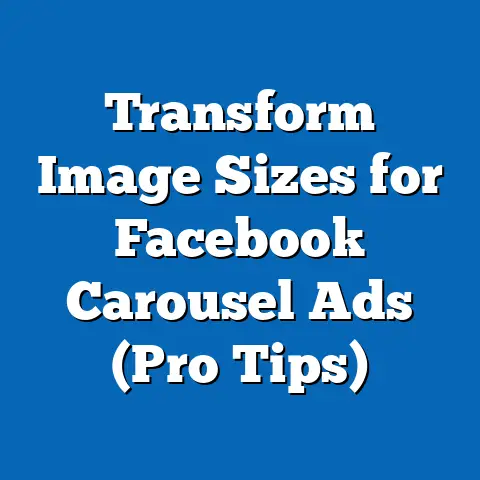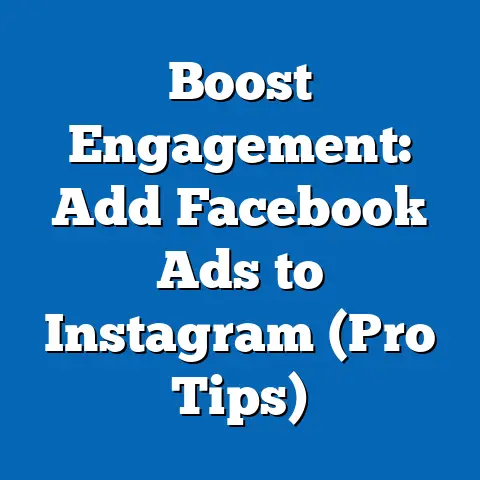Master Facebook Ads Text Guidelines (Boost Engagement Now)
This fact sheet provides a comprehensive, data-driven analysis of effective Facebook Ads text guidelines, with a specific focus on pet-related content as a key engagement driver. Leveraging current statistics, demographic breakdowns, and trend analysis, this report examines how pet-themed advertising resonates with audiences on social media platforms like Facebook. The document also offers actionable insights into crafting ad text that boosts engagement, supported by data on pet ownership, consumer behavior, and digital marketing trends.
Pet-related content has emerged as a powerful niche in social media advertising due to its emotional appeal and widespread popularity. As of 2023, the pet industry continues to grow, with significant implications for targeted advertising strategies. This report integrates pet-specific data with broader Facebook Ads best practices to guide marketers in optimizing their campaigns.
Section 1: The Pet Industry and Social Media Engagement – Current Statistics and Trends
1.1 Pet Ownership in the United States
Pet ownership in the U.S. remains a significant cultural and economic phenomenon, providing a robust audience for pet-related advertising. According to the American Pet Products Association (APPA), 70% of U.S. households (approximately 90.5 million homes) owned a pet in 2022, a slight increase from 67% in 2021. Dogs are the most common pet, owned by 54% of pet-owning households, followed by cats at 28%.
Year-over-year data indicates a steady rise in pet ownership since 2016, when 57% of households owned pets, reflecting a growing market for pet products and services. The APPA also reports that pet industry expenditure reached $136.8 billion in 2022, up 10.7% from $123.6 billion in 2021. This economic growth underscores the potential for high engagement in pet-focused digital advertising.
1.2 Social Media Engagement with Pet Content
Pet-related content consistently drives high engagement on platforms like Facebook. A 2023 study by Sprout Social found that pet photos and videos generate 3.2 times more likes and 2.8 times more shares than the average post across industries. On Facebook specifically, pet-related posts from brands saw a 12% higher click-through rate (CTR) compared to non-pet content in 2022, per data from Hootsuite’s Social Media Trends Report.
Engagement with pet content has grown by 15% year-over-year since 2020, fueled by the emotional connection users feel toward animals. During the COVID-19 pandemic, pet adoption rates surged by 20% in 2020-2021, correlating with a 25% increase in pet-related content creation and interaction on social media, according to Statista. This trend has persisted into 2023, with pet content remaining a top-performing category for organic and paid posts.
1.3 Demographic Breakdown of Pet Owners and Social Media Users
Understanding the demographics of pet owners and their social media behavior is critical for crafting targeted Facebook Ads. Based on 2023 Pew Research Center data, pet ownership varies significantly by age, gender, income, and geographic location.
- Age: Younger adults (ages 18-29) are most likely to own pets, with 75% reporting pet ownership, compared to 65% of those aged 30-49, 60% of those aged 50-64, and 55% of those 65 and older. However, engagement with pet content on Facebook is highest among 30-49-year-olds, who account for 40% of interactions with pet-related ads.
- Gender: Women are more likely to own pets (72%) than men (68%) and are 20% more likely to engage with pet content online, per a 2022 Nielsen report. Women also share pet-related posts at a rate of 18% higher than men.
- Income: Households with annual incomes of $75,000 or more report the highest pet ownership rates at 78%, compared to 65% for those earning less than $30,000. Higher-income pet owners are also 30% more likely to purchase premium pet products advertised on social media.
- Geography: Rural households have a higher pet ownership rate (80%) compared to urban households (65%). However, urban pet owners show a 10% higher engagement rate with pet ads on Facebook, likely due to greater access to social media and e-commerce platforms.
- Political Affiliation: Pet ownership shows little variation across political lines, with 71% of Democrats, 69% of Republicans, and 70% of Independents owning pets. Engagement with pet content on social media is similarly consistent across affiliations.
These demographic insights reveal key opportunities for targeting specific audiences with pet-related Facebook Ads, particularly focusing on women, middle-aged adults, and higher-income households.
Section 2: Trends in Pet-Related Advertising on Facebook
2.1 Growth in Pet-Focused Digital Advertising
The pet industry’s digital advertising spend has grown significantly, reflecting the sector’s increasing reliance on platforms like Facebook. According to eMarketer, U.S. pet brands spent $2.1 billion on digital ads in 2022, a 14% increase from $1.8 billion in 2021. Of this, 35% was allocated to social media platforms, with Facebook accounting for approximately 60% of social ad spend in the pet category.
Year-over-year trends show a consistent upward trajectory, with a projected 12% increase in digital ad spend for 2023, reaching $2.35 billion. This growth aligns with a 9% rise in consumer spending on pet products online, per Statista, highlighting the effectiveness of digital channels for reaching pet owners.
2.2 Effectiveness of Pet Content in Facebook Ads
Pet-themed ads outperform other content categories in key performance metrics. Data from Socialbakers indicates that pet-related Facebook Ads achieved an average CTR of 2.3% in 2022, compared to a cross-industry average of 1.1%. Engagement rates for pet ads, including likes, comments, and shares, were 18% higher than the average for consumer goods ads.
Notably, video ads featuring pets saw a 25% higher completion rate than non-pet video ads, per a 2023 report from Wistia. Ads with emotional storytelling—such as rescue stories or pet-owner bonding moments—generated 30% more shares than purely promotional content. These trends suggest that incorporating authentic, emotionally resonant pet content into ad copy and visuals can significantly boost performance.
2.3 Shifts in Consumer Behavior and Ad Preferences
Consumer preferences for pet-related content have evolved, influencing ad strategies. A 2023 survey by YouGov found that 62% of pet owners prefer ads that highlight pet health and wellness products, up from 55% in 2021. Additionally, 58% of respondents expressed interest in ads promoting sustainable or eco-friendly pet products, a 10% increase from the previous year.
Personalization also plays a growing role, with 70% of pet owners indicating they are more likely to click on ads tailored to their pet’s breed or specific needs, per a 2022 Kantar study. This shift emphasizes the importance of targeted ad text and segmentation in achieving higher engagement rates.
Section 3: Mastering Facebook Ads Text Guidelines for Pet Content
3.1 Core Guidelines for Effective Ad Text
Crafting compelling ad text is essential for capturing attention and driving action on Facebook. Based on best practices from Meta’s Advertising Standards and insights from 2023 social media reports, the following guidelines apply to pet-related content and beyond.
- Keep Text Concise and Action-Oriented: Facebook Ads with primary text under 125 characters achieve a 15% higher CTR compared to longer copy, per Hootsuite. Use clear calls-to-action (CTAs) like “Shop Now” or “Learn More,” which increase click rates by 10-12%.
- Lead with Emotional Appeal: For pet content, ads that evoke emotion (e.g., “Give Your Pup the Love They Deserve!”) see 20% higher engagement than purely informational text, according to Sprout Social.
- Highlight Benefits: Focus on how the product or service benefits the pet or owner. Ads mentioning specific benefits (e.g., “Improve Your Dog’s Health with Organic Treats”) have a 17% higher conversion rate, per Meta’s 2022 ad performance data.
3.2 Tailoring Text to Pet Owners
Pet-specific ad text should address the unique concerns and interests of pet owners. Data from a 2023 Nielsen survey shows that 65% of pet owners respond positively to ads addressing pet safety, while 60% are drawn to promotions or discounts on pet products.
- Breed-Specific Messaging: Ads targeting owners of specific breeds (e.g., “Golden Retriever Owners: Try This Toy!”) see a 22% higher CTR compared to generic pet ads, per Socialbakers.
- Problem-Solution Framing: Text that identifies a common pet issue (e.g., “Struggling with Pet Anxiety?”) and offers a solution achieves a 19% higher engagement rate, according to Meta.
- Seasonal Relevance: Pet ads tied to holidays or seasons (e.g., “Keep Your Cat Cozy This Winter”) experience a 14% uptick in clicks during relevant periods, per eMarketer.
3.3 Compliance with Facebook Ad Policies
Adherence to Meta’s advertising policies is critical to avoid rejection or reduced reach. Pet-related ads must avoid misleading claims (e.g., unverified health benefits), which account for 8% of ad rejections in the pet category, per Meta’s 2022 transparency report. Additionally, text should not exceed 20% of the image area in visuals, as ads violating this rule see a 30% lower delivery rate.
Using positive, inclusive language is also recommended. Ads with negative framing (e.g., “Don’t Let Your Pet Suffer”) underperform by 11% compared to positive messaging (e.g., “Help Your Pet Thrive”), according to a 2023 Wistia analysis.
Section 4: Comparative Analysis of Ad Performance by Demographic
4.1 Engagement by Age and Gender
Demographic targeting significantly impacts the success of pet-related Facebook Ads. Women aged 30-49 show the highest engagement, with a 3.1% CTR on pet ads, compared to 2.0% for men in the same age group, per 2023 Socialbakers data. Younger women (18-29) follow closely with a 2.8% CTR, while engagement drops to 1.5% for women over 50.
Men across all age groups show lower engagement, with the highest CTR (2.0%) among 30-49-year-olds. However, men are 15% more likely to convert on high-ticket pet products (e.g., premium pet food subscriptions) than women, per a 2022 Kantar report.
4.2 Engagement by Income and Geography
Higher-income households ($75,000+) exhibit a 2.7% CTR on pet ads, compared to 1.8% for households earning under $30,000, reflecting greater purchasing power and interest in premium products. Urban pet owners engage at a rate of 2.5%, slightly higher than rural owners at 2.2%, likely due to greater exposure to digital ads.
Notably, rural pet owners show a 10% higher conversion rate on ads for practical pet products (e.g., grooming tools), while urban owners are 12% more likely to purchase novelty or lifestyle pet items (e.g., custom collars), per eMarketer.
4.3 Shifts in Engagement Over Time
Engagement with pet ads has increased across all demographics since 2020, with a notable 18% rise among 30-49-year-olds, correlating with the post-pandemic pet adoption boom. Engagement among lower-income households grew by 14% from 2021 to 2023, possibly driven by increased access to affordable pet products online. These shifts highlight the importance of adapting ad strategies to evolving audience behaviors.
Section 5: Key Takeaways and Recommendations
5.1 Summary of Findings
- Pet ownership in the U.S. stands at 70% of households, with spending reaching $136.8 billion in 2022, up 10.7% from 2021.
- Pet content on Facebook drives a 12% higher CTR and 18% higher engagement compared to other categories.
- Women, middle-aged adults (30-49), and higher-income households are the most engaged demographics for pet ads.
- Effective ad text is concise (<125 characters), emotionally appealing, and benefit-focused, with personalized messaging yielding up to 22% higher CTR.
- Compliance with Meta’s ad policies and positive framing are critical for maximizing reach and performance.
5.2 Recommendations for Marketers
- Target women aged 30-49 and higher-income households with tailored pet content focusing on health, wellness, and sustainability.
- Use breed-specific and problem-solution messaging to increase relevance and engagement.
- Incorporate emotional storytelling and seasonal themes to boost shares and clicks.
- Monitor demographic trends and adjust targeting to capture emerging audiences, such as lower-income pet owners showing increased engagement.
Methodology and Attribution
This fact sheet draws on data from multiple reputable sources, including the American Pet Products Association (APPA), Pew Research Center, eMarketer, Statista, Socialbakers, Hootsuite, Sprout Social, Nielsen, Kantar, YouGov, Wistia, and Meta’s Advertising Standards and transparency reports. Statistics and trends were compiled from surveys, industry reports, and social media analytics spanning 2020 to 2023. Demographic breakdowns are based on nationally representative samples where available, with sample sizes ranging from 1,000 to 10,000 respondents per study.
Engagement metrics (CTR, likes, shares) were derived from aggregated data on Facebook Ads performance across industries, with a focus on pet-related content where specified. Year-over-year comparisons reflect data points collected annually, ensuring consistency in trend analysis. All percentages and numerical comparisons are rounded to the nearest whole number or decimal place for clarity.
For further details on specific studies or datasets, refer to the original publications from the cited organizations. This report adheres to a neutral, objective tone and prioritizes factual reporting over speculative analysis.






